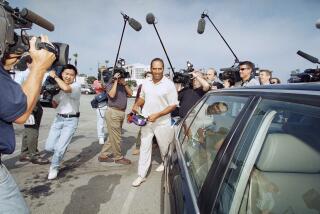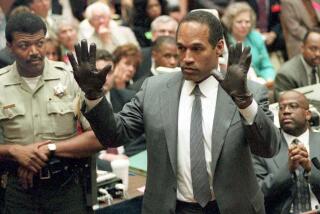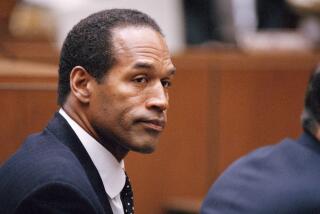Op-Ed: How the media help drive harsh criminal justice policies
On April 21, 1989, the New York Daily News ran a story about a young investment banker who was badly beaten and repeatedly raped while jogging in Central Park. Its headline, “Wolf Pack’s Prey,” described how the woman was “left for dead by a wolf pack of more than a dozen young teenagers.” News stories about the crime appeared in every major media outlet and made the term “wilding” part of the national lexicon. The stories rarely described the perpetrators as “alleged.”
The trouble was, the “pack” wasn’t responsible for the attack, although five young men arrested soon thereafter were convicted of the crime and served between six and 13 years. In 2002, they were exonerated after a convicted rapist confessed to having raped the woman and police matched his DNA to the crime scene.
The story of these five young men of color is again in the news because of Ava DuVernay’s Netflix series, “When They See Us,” which focuses on the experiences of the boys who were wrongly accused. For media outlets, the series, which is available for streaming, provides a good opportunity to examine how news coverage has contributed to wrongful convictions and, more generally, to decades of draconian criminal justice policy.
In the American media, coverage of violent crime rose sharply just as the rate of violent crime actually began to fall.
After the real rapist confessed, some journalists — not many — conceded that they had bought in too readily to a false narrative concocted by police and prosecutors. As LynNell Hancock, who covered the story for the New York Daily News, pointed out in 2003, the real “wolf pack” had been the media.
There are plenty of examples of times the media wrongly joined that pack. “Crack crazed teen stabs mom to death,” screamed a New York Post headline about 16-year-old Huwe Burton in the same year as the Central Park jogger story. The son turned out not to have been the perpetrator, although he served nearly 20 years in prison for a murder he didn’t commit before his conviction was officially overturned this year.
In 1994, three teenagers were convicted of murdering three young boys in West Memphis, Ark., after a spate of headlines like, “Teen Describes ‘Cult’ Torture of Boys.” One story included quotes from an unnamed source claiming she’d seen one of the defendants drink his girlfriend’s blood. They served 18 years before being exonerated.
Obviously the media aren’t solely to blame for such wrongful convictions. Jim Dwyer, who wrote about the Central Park jogger case for Newsday, described the story as “a centrifuge [in which] everyone was pinned into a position — the press, the police, the prosecution — and no one could press the stop button.” And it’s worth noting that journalists also help get people like the West Memphis Three out of prison, by digging into old cases and getting them back on the front page (though rarely is the exoneration covered as heavily as the crime).
But journalists have also helped drive decades of harsh criminal justice policy. In the American media, coverage of violent crime rose sharply just as the rate of violent crime actually began to fall. From 1990 to 1992, the evening broadcasts of the three major networks averaged fewer than 100 murder stories each year. By 1999, they were broadcasting an average of 511 murder stories per year, although the homicide rate plummeted 40% during the 1990s. It has fallen further since, to its lowest rate in 40 years. Yet crime remains the No. 1 topic on local television news. According to one study, people who watch television news every day are 16% more likely to support punitive criminal justice policies.
One thing that drove the increased crime coverage was shrinking media budgets. Producing an hourlong television “news magazine” costs a fraction of what it does for an hour of a scripted show — and 20% to 40% of TV news magazines are devoted to crime, notes Duke University law professor Sara Sun Beale. “Entertainment increasingly means crime and justice,” she says.
And it’s easier to cover crime as an event than to cover criminal justice policy. The Marshall Project, where I work, is able to cover criminal justice extensively (and individual crimes almost not at all), primarily because we are a nonprofit.
Enter the Fray: First takes on the news of the minute »
With prison populations now falling slightly and crime rates near historic lows, it seems like the right time to change how we cover crime. But that hasn’t happened yet. In fact, the term “wilding” popped up just last month in a story about black teenagers in Chicago.
Too often, news stories reinforce racial stereotypes. In the early 2000s, for example, a study found that black people were four times as likely to be represented as criminals than as police in television news, and the effects of that linger.
The presence of more people of color in American newsrooms might help to mediate these biases, but U.S. newsrooms remain stubbornly monochromatic. The most recent study from the American Society of Newspaper Editors found that diversity has “lost ground” in recent years. People of color represented only 22% of the workforce in newsrooms that responded to their survey. And most did not even bother to respond. (The Marshall Project’s diversity report is here.)
Donald Trump infamously took out full-page ads calling for the reinstatement of the death penalty so that the “Central Park Five” could be executed. Journalists who rush to condemn that travesty would do well to examine how the media cover criminal justice, both then and today.
Carroll Bogert is president of The Marshall Project, a nonprofit journalism organization covering the U.S. criminal justice system.
More to Read
A cure for the common opinion
Get thought-provoking perspectives with our weekly newsletter.
You may occasionally receive promotional content from the Los Angeles Times.










